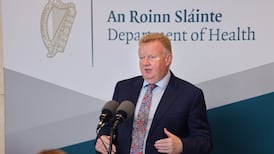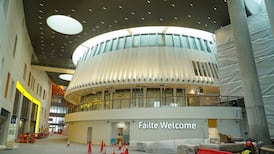By the end of this year, Prof Shane Higgins jokes, Ireland could have its first State-funded babies.
The master of the National Maternity Hospital is referring to the fact that a first tranche of 50 couples have been referred by staff to its fertility wing for IVF treatment under the Government’s new assisted human reproduction scheme.
It is just one instance that shows how this maternity hospital is evolving into one covering most of the female life-cycle. The birth-rate is declining, but activity in other areas is soaring – fertility, menopause, terminations and genetics.
Almost 7,000 babies were born in the hospital in 2023. “It’s about women’s health now, more than purely maternity,” Prof Higgins says, highlighting the wide mix of initiatives being undertaken in the hospital.
READ MORE
The first women to receive State-funded IVF are being referred to the not-for-profit Merrion fertility unit next door to the NMH. The hospital says it is the first to have a full-time perinatal geneticist on staff, who last year dealt with a “staggering” 650 referrals. The service provides diagnoses of rare genetic conditions in babies during pregnancy using the rapidly-developing new technology.
The hospital hopes it will be funded by the HSE as a national service in early 2024.
The NMH’s protracted move from Holles Street to the St Vincent’s University Hospital campus takes another small step forward this year with the beginning of enabling works on the site and the start of the procurement process for the main hospital building.
However, between procurement and construction, the hospital, whose move was first announced in 2013, won’t be ready until 2030 at the earliest.
Prof Higgins declines to estimate the cost of the project, saying a better sense of this should emerge after the building quotes are received.
Asked whether the pitfalls that befell the national children’s hospital project at St James’s can be avoided, he says the process for moving the NMH has been “extremely robust” to date. “The design has been done, down to where every socket goes, so I don’t see any opportunity for add-ons to the final price. But it will be important that those leading the project keep a tight hold on the reins.”
A falling birth rate nationally has led some to question whether the move is even necessary. Prof Higgins points out that the birth rate is projected to rise again in a few years.
“This is the single biggest investment in women’s health and it’s needed. The youngest building on our site now is nearly 90 years old. We’re operating well beyond the capacity of this campus and have been for years.
One in eight mothers delivering at the hospital now is aged over 40, he points out.
“Quality healthcare needs a modern building. Down the corridor from my office, there are up to 14 women in a ward, separated by curtains. That’s not dignified, or comfortable, or acceptable. A new maternity hospital of the size and scale planned – three times our current footprint – is critical. It should have been done a long time ago.”
One of the main reasons for the delay in moving arose from concerns the NMH could be unduly influenced by the Catholic ethos then pertaining at St Vincent’s. Higgins declines to estimate how much time was lost to the long-running rows over the issue.
He remains steadfast in his view that the hospital will retain its independence after moving to St Vincent’s. “I would never stand over a move where there was involvement in our services by the religious orders. There will be no interference in the services we provide on the campus of the NMH when it moves. We fought hard to retain our independence and our voluntary status, and that will be reflected in what we do as a maternity hospital at St Vincent’s. We will be providing the services that we currently provide, plus additional ones, in exactly the same fashion that we have done here for decades.”
On Dublin’s northside, the Rotunda Hospital is developing several projects on its campus and moving some services to buildings around the city centre, but Prof Higgins says this is not an option for the NMH due to the lack of space on its site.
Still, the hospital is hoping to build a new walk-in gynaecology unit, clinical decontamination unit, pathology suite and a new patient lift – the current one dates from the 1960s and can’t fit a hospital bed with the sides on.
Pre-planning meetings with Dublin City Council have taken place about the lift, which is planned for the exterior of Holles Street, near the main entrance to the hospital.
“The car park we have is tiny and there’s a limit as to how high you can go. It would be a worthless investment to invest the sort of money that the Rotunda are putting into their site. Besides, the move to St Vincent’s is still very much going ahead.”
The NMH was one of the first hospitals to provide terminations when they were legalised in 2018, and has found itself the target for anti-abortion protests.
While he feels the termination service has worked well, Prof Higgins singles out a lack of clarity around the 28-day cutoff for fatal fetal anomalies as a source of concern. “Clinicians are having to soul search at multi-disciplinary team meetings whether a baby, if it were born, will or will not survive beyond 28 days because of the wording of the legislation.”
Palliative care for couples who decide not to proceed with a termination could also be expanded, he believes.
Though the protests appear to have died down, he is looking forward to the forthcoming implementation of legislation providing for “safe access zones” outside facilities providing abortion services. “I couldn’t even give you a month the last time I saw anyone. Very occasionally we’ll have two or three people standing up in the corner of Merrion Square. I think it’s important to protect patients and staff who might want to access the service (who) would feel much more comfortable knowing they are not going to encounter protests.”
Now five years into a seven-year term as master, the 60-year-old says Holles Street remains a great place to work in. “Hand on heart, this is by far the nicest place I’ve ever worked in – the collegiality, the pride, everyone on a first-name basis.”
- Sign up for push alerts and have the best news, analysis and comment delivered directly to your phone
- Find The Irish Times on WhatsApp and stay up to date
- Our In The News podcast is now published daily - Find the latest episode here




















